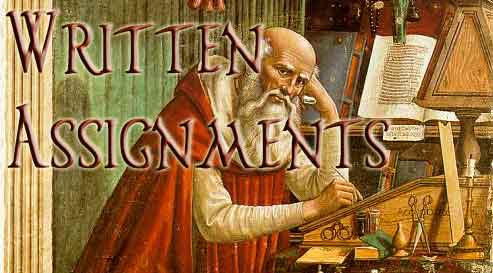

|
GENERAL PAPER WRITING GUIDELINES These general guidelines apply to both essays for this course. If you have questions about format, organization, or sources that are not covered below, please feel free to contact the professor.
I. Format Both of your papers should be around five pages in length, double-spaced, and printed in a reasonable-sized font (preferably, Times New Roman, 12 pt.) on clean, white paper.
Please do not use colored fonts, please do not include images or graphs or charts (these should be unnecessary). Please do not include a five line header on every page: your name need only appear on the first page. Please make sure your assignment is stapled together, and that your pages are numbered.
Do not play spacing or font games to make your papers longer or shorter: this will only anger the grading gods. If your paper comes out slightly shorter or slightly longer than five pages (say, 4 1/2 pages or 6 pages), but you feel you have adequately answered the question and fulfilled the assignment this is fine. The five-page guideline is meant to give you a general idea of how in-depth your essay should be.
II. Organization Each essay assignment asks you to examine closely a single text, or to compare two or more texts with a specific topic in mind. The overall goal of these assignments is to demonstrate that you have achieved a sophisticated understanding of the various issues and concerns that played a role in the formation of ancient Christian identities.
For each essay, you should try to come up with a central, organizing idea (or COI). Your COI does not have to be an original argument or thesis statement, merely an idea which will serve to organize your particular response to the essay question.
For instance, if the essay assignment asked you to discuss the role of nature in the Life of Antony, your COI might be as simple as:
You should state this COI early (in the first paragraph or so of your paper), and then proceed through the rest of your paper to give examples from the text or texts that demonstrate your COI.
A simple structure can be most effective for such a short essay. Once you have your COI, try to think up three or four sets of examples from your text or texts that help support this idea. In your opening paragraph or two, tell the reader what these supporting examples will be, and then spend the rest of your paper going through them. Finish up by drawing some conclusion from this COI and its supporting examples.
For instance, using the COI example from above, you might propose (please note, these examples are entirely made up and untrue!):
You would then go on to spend a paragraph or two describing more specifically how weather and mental state are used in the first part, and then a few paragraphs discussing geography, and so on. Voila: paper.
Your opening paragraphs are very important, because they provide a roadmap for your reader. It's fine to sit down and write down all your ideas (in fact, I recommend doing this as you read through the texts to prepare to write your essay). But you must have some sense of organization when you actually write the paper, or else your reader will be lost.
Be sure to quote from the text when relevant, but do not fill up the paper will long, meaningless citations of the text or summaries of its contents. Assume your reader has also read the text: only cite passages that are relevant to your COI. Only give information that supports your COI. If it is not relevant to your analysis of the Life of Antony that Athanasius spent several years in exile, or had brown hair, or was a Sagittarius, then do not include that information. Likewise, make sure relevant information appears where it best supports your argument.
III. Sources This assignment is a close reading of a single text, or a comparison of two or more texts: for this reason, you really don't need to cite anything outside of the text itself. You may find it necessary to cite the introductions from the sourcebook or the Chadwick book for contextual information. For example, (again, entirely made up example!):
If you do cite secondary sources (either in quotation marks or generally), be sure to provide a citation that shows where the information comes from (as the example shows).
Do not do any outside research. Do not check books out of the library. Do not consult outside website, encyclopedias, or commentaries on ancient Christianity. This paper should be your own analysis of an ancient Christian text or texts.
To view the essay assignments, click the links below (a new window will open so you can print out the assignment):
ESSAY #1: DUE MONDAY APRIL 23 (BEGINNING OF CLASS)
ESSAY #2: DUE WEDNESDAY MAY 30 (BEGINNING OF CLASS)
|
Illustration: Domenico Ghirlandaio, "Saint Jerome (in his study)" (1480)